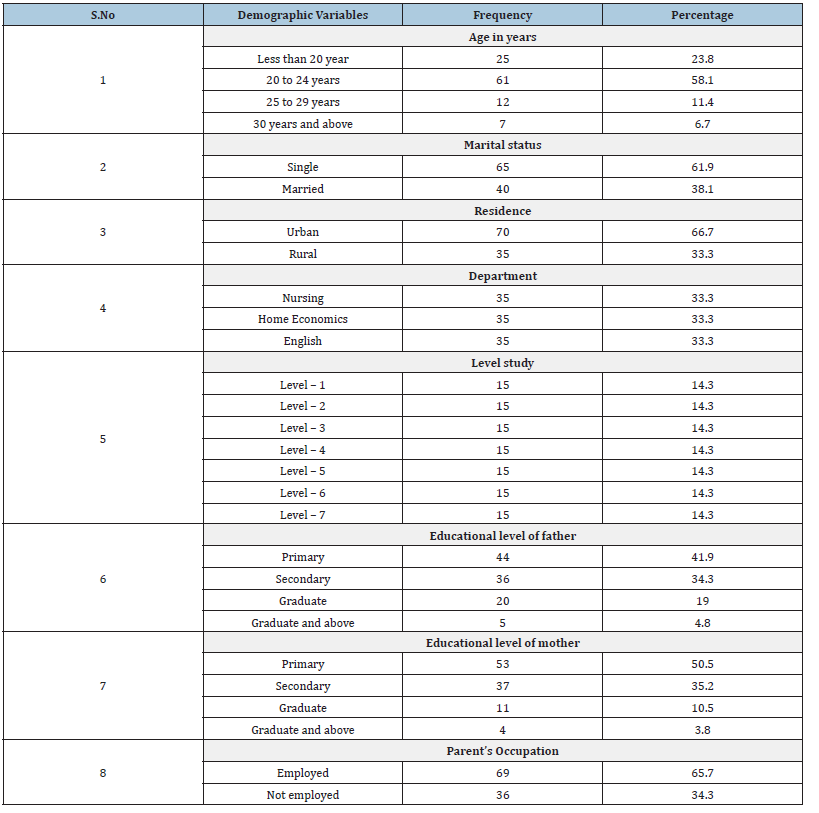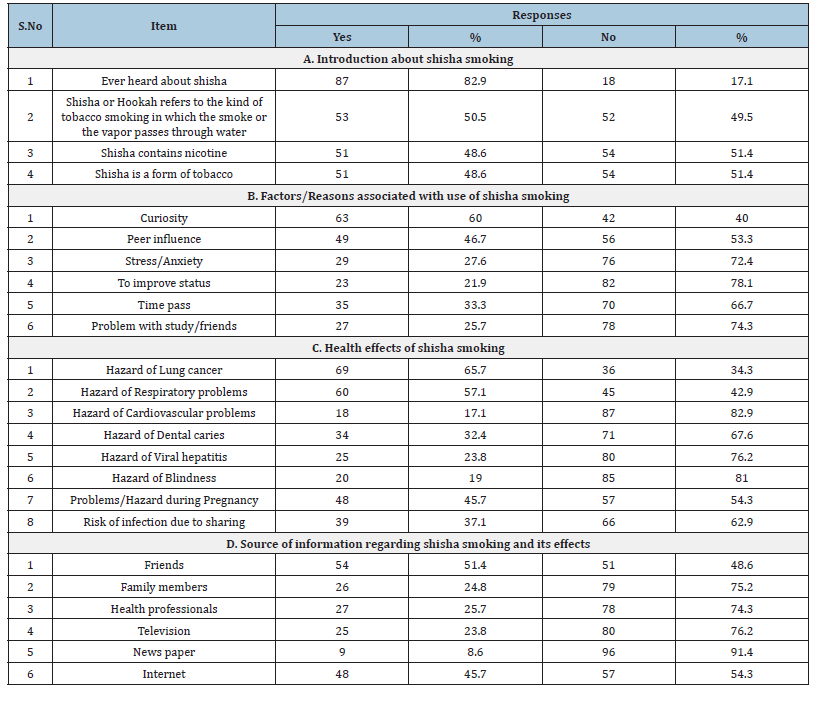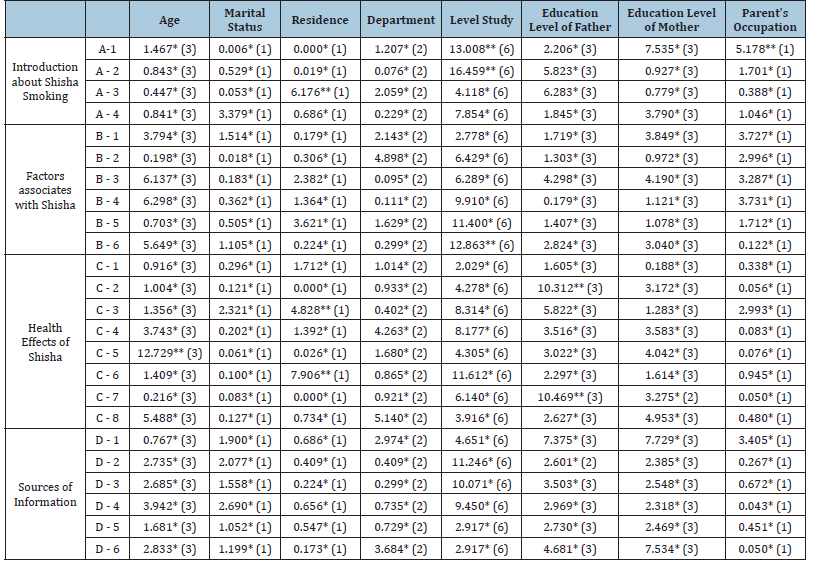- Submissions

Full Text
Biodiversity Online J
Knowledge about Shisha Smoking and its Health Effects among Selected Girls College students, Farasan
Sumathi Nagarajan* and Alawia Abdulrehman
Department of Nursing, University College Farasan, Saudi Arabia
*Corresponding author:Sumathi Nagarajan PhD (N), Assistant Professor, Department of Nursing, University College Farasan, Saudi Arabia
Submission: April 01, 2023; Published: September 08, 2022

ISSN 2637-7082Volume4 Issue2
Abstract
Tobacco use in any form of preventable cause for disease and death across the globe. Most severely affected countries are from low and middle income [1]. Tobacco use is second major leading cause of death and is currently responsible for the death of one in ten adults across the world. Tobacco use is a major risk factor for many health problems. The World Health Organization (WHO) estimates that over one billion individuals recently smoke tobacco, with approximately five million deaths a year being attributed to tobacco. If this pattern of smoking continues, WHO estimates that tobacco-attributable mortality will exceed eight million deaths per year by 2030 (WHO, 2008). Shisha is also known as Narghile, hookah, Hubble bubble and water pipe in different cultures and countries. It is a way of smoking tobacco in which the vapor passes through water before inhalation. At present, Shisha is becoming an increasingly popular way of smoking use worldwide. It finds the way from Eastern Mediterranean region, and is now gaining popularity in western countries including Australia, UK, Canada and USA. Recently shisha has been considered as a global threat and given the status of an epidemic by public health officials. Tobacco smoke contains over 4800 different chemicals out of which 69 are carcinogens and several others are tumor promoters. According to the Expert warns against smoking shisha- Arab News in 2018: Smoking Hookah, a water pipe used to smoke shisha and flavored tobacco and it has become more popular among teenagers and young adults. Cigarette smoking has significantly declined in the past decade, but the popularity of hookah is increasing. The hookah is a water pipe that uses charcoal to heat shisha - a flavored blend of herbal substances. Some shisha contains tobacco, which has nicotine and can be addictive. Smoke from hookahs can contain carbon monoxide and other toxic chemicals known to increase the risks for smokingrelated cancers, heart disease and lung disease. This trend is attracting more teenagers and young adults. The rate of those students who ever tried hookah went up from about 9 percent to 13 percent between 2008 and 2014. Knowledge of students regarding shisha is that because the smoke passes through water, the vapor is less harmful. The amount of puffs taken during an hour-long hookah session could be about 10 times more than when smoking just one cigarette. People should have more information about what the consequences are for whatever they use. It’s about protecting the consumer. Secondhand smoke from Hookahs can also be a health risk for non-smokers and kids. Three most common places for teenagers to smoke hookah is in their own home, a friend’s house, or another family member’s home. Shisha tobacco is more flavorful than cigarettes coming in a variety of fruits and floral aromas, it contains same toxicants known to cause lung cancer, heart diseases, respiratory problems, mouth cancer and complications during pregnancy. In Saudi Arabia the scenario, 63.8% students start smoking shisha at ages of 16–18 years [2] youth mainly in the university and college students. Thus, the investigator being the specialist in the area of community health nursing focus attention towards to study knowledge about shisha smoking and its health effects among college girl students.
Keywords:Knowledge; Shisha smoking; Health; Effects; Girls; College students
Objectives
a) To assess the knowledge about shisha smoking and its health effects among selected
girls college students.
b) To associate the knowledge about shisha smoking and its health effects among
selected girls college students their demographic variables.
Materials and Methods
The present study was conducted among 105 girl students of University College Farasan from department of Nursing, Home economics and English department respectively. The descriptive research design was used for the study. The samples which met the inclusion criteria are selected for the study by using convenient sampling technique. The study was conducted after obtaining the formal permission from the head of the institution to ensure anonymity. The informed consent was obtained from the study participants. No name was written in the demographic data of the participants. The data collection was done by self-administered structured questionnaire which includes demographic data such as age, marital status, residence, department, year of study, educational level of parents, and occupation of parents. Knowledge aspects regarding shisha smoking and its health effects includes introduction about shisha smoking, factors/reason associated with use of shisha, health effects of shisha smoking and source of information. Participants were instructed to fill up the questionnaire. The data were analyzed by using descriptive and inferential statistics [3-5].
Results
From the findings of the demographic data. It can be observed that the highest percentage (58.1%) of the respondents are from the age group 20-24 years, 61.9% respondents are unmarried (Single), 66.7% respondents are living in Urban areas, 41.9% respondent fathers educational qualification and 50.5% respondents mothers educational qualification is Primary level only. 65.7% respondent’s parents are employed (Table 1).
Table 1:Demographic characteristics of the female students from University College Farasan (N=10 -From each department 35 samples).

With regard to knowledge aspect of shisha smoking shows that around 51% of the respondents are known shisha or hookah refers to the kind of tobacco smoking in which the smoke or the vapor passes through water and not aware of shisha contains nicotine and it is a form of tobacco respectively. Factors related to use of shisha smoking, observed that, 60.0% of the respondents are known that curiosity is associated with use of shisha smoking whereas 53.3% of the respondents are don’t know about peer influence is a factor associated with use of shisha smoking. Highest (78.1%) percentage of the responded not knowing that shish smoking not improve the status and 66.7% of the respondents not knowing it because of time pass only. More or less similar percentage of the respondents are not knowing about Stress/ Anxiety and Shisha smoking are associated (72. 4%) and problem with study/ friends are not a reason for using shisha smoking (74.3%). However, Health effects of shisha smoking shows that highest percentage of the responded knowing answers for the item, Hazard of Lung Cancer (65.7%) and Hazard of Respiratory problems (57.1%) because of shisha smoking, whereas highest percentage of the responded not knowing answers for the item, Hazard of Cardiovascular problems (82.9%), Dental caries (67.6%), viral hepatitis (76.2%), Blindness (81.0%), problems during pregnancy (54.3%) and risk of infection due to sharing (62.9%) respectively. Further, majority of the respondents are not knowing information from News Paper (91.4%), Television (76.2%), and Family members (75.2%), Health professionals (74.3%) and Internet (54.3%) respectively. Further, it is also observed that 51.4% of the respondents are getting information regarding shisha smoking from friends and 54.3% of the respondents are not getting any information from Family members (75.2%) Health professionals (74. 3%) Television (76. 2%), News Paper (91.4%) and Internet (54.3%) respectively (Table 2). From the Chi square (Table 3), it is observe that there is a significant associations between Viral Hepatitis and Age, Shisha contains Nicotine and Residence, Cardiovascular Problems and Residence, Blindness and Residence, Ever Heard about Shisha and Level of Study, Ever Heard about Shisha and Level of Study, Problem with Friends and Level of Study, Respiratory Problems and Education level of Father, Problems during pregnancy and Education level of Father. On the other hand, there is no significant associations are found between remaining factors [6-8]. A Kruskal– Wallis H test Table 4 shows that the comparison between the study variables (i.e., levels of “Introduction about Shisha Smoking, Factors associates with Shisha, Health Effects of Shisha, Sources of Information”) and demography variables (i.e., levels of “Age, Marital Status, Residence, Department, Level Study, Education Level of Father, Education Level of Mother, Parents Occupation). There is a significant difference between the opinion about “Ever heard about shisha” and “Level Study”, with highest mean rank 65.00 for the group “Level 1”. Similarly, for the opinion about “Ever heard about shisha” and “Parents Occupation”, with the highest mean rank 56.17 for the group “Employed” [9-13]. Also, observed that there is a significant difference between the opinions about “Shisha Contain Nicotine”, “Cardiovascular Problems” and “Blindness” with “Residential Area” with highest mean rank respectively as “57.5”, “56.00” and “57.00” for the group “Urban”. Similarly, it can also be observed that, there is a significant difference between the opinions about “Ever heard about Shisha Smoking”, “Shisha Smoking refers to the kind of Tobacco Smoking”, “Problem with Study/ Friends” and “Level of Study” with highest mean rank “65.00”, “72.5”, “66.50” for the Levels respectively as “Level 1”, “Level 2” and “Level 5”. There is a significant difference between the opinions about “Respiratory Problems”, “Problems during Pregnancy” and “Education level of Father” with highest mean rank “83.00”, “59.50” for the education level “Graduate & Above”, “Secondary” respectively. Finally, it can observed that there is a significant difference between the opinion about “Ever heard about Shisha Smoking” and “Parent’s Occupation” with highest mean rank “56.17” for the factor “Employed”. On the other hand there is no significant associations are found between remaining factors (Table 4).
Table 2:Assessment of knowledge about shisha smoking and its health effects N=105.

Table 3:Chi square test.
Note: *p > 0.05 (Not significant); **p < 0.05 (Significant); ***p = 0.000 (Highly significant).

Table 4:Kruskal-Wallis H test [Highest mean rank].

Conclusion
To sum up, we may say that the poor knowledge about shisha smoking and its health effects among these participants. Though health awareness campaign was conducted at national level still the issues are going on as a major. Further periodical health promotional activities could solve the problem by advertisements and improve their knowledge about shisha use. Enforcement of laws to be implemented with penalty for the shisha users. Curriculum to be implemented with their course of study itself to build good characters.
References
- Sameerur R, Sadiq MA, Parekh MA, Zubairi AB, Frossard PM, et al. (2012) Cross-sectional study identifying forms of tobacco used by Shisha smokers in Pakistan. J Pak Med Assoc 62(2):192–195.
- Brockman LN, Pumper MA, Christakis DA, Moreno MA (2012) Hookah's new popularity among US college students: A pilot study of the characteristics of hookah smokers and their Facebook displays. BMJ Open 2(6): e001709.
- Hafiz MA, Shafaq S, Sidra G, Wardah A (2014) Harmful effects of shisha: Literature review. Int Arch Med 4(7).
- Taha AZ, Sabra AA, Al Mustafa ZZ, Al Awami HR, Al Khalaf MA, et al. (2010) Water pipe (shisha) smoking among male students of medical colleges in the eastern region of Saudi Arabia. Ann Saudi Med 30(3): 222–226.
- Experts warn of dangers from smoking hookah.
- Omotehinwa OJ, Ogendi J, I Jean Damascene, Michael Habtu (2018) Shisha use among students in a private university in Kigali city, Rwanda: prevalence and associated factors. BMC Public Health 18:713.
- Abdullah SA, Majed KA, Salwa Al (2014) Smoking among dental students at King Saud University: Consumption patterns and risk factors. The Saudi Dental Journal 26(3): 88-95. .
- Najla SD, Faris GB, Mahmoud KA, Hamzeh MA, Hazem A Eimar, et al. (2010) Narghile (water pipe) smoking among university students in Jordan: prevalence, pattern and beliefs. Harm Reduct J 24(7): 10.
- AIA Haqwi, H Tamim, Ali Asery (2010) Knowledge, attitude and practice of tobacco smoking by medical students in Riyadh, Saudi Arabia. Ann Thorac Med 5(3): 145-148.
- Wasim M, Thomas E, Samer R, Fadi H, Taghrio A, et al. (2004) Beliefs and attitudes related to narghile (waterpipe) smoking among university students in Syria. Ann Epidemiol 14(9): 646-654.
- Abdulaziz F, Abdalla AS, Abdelshakour MA, Hashim AH, Ali AM (2011) Prevalence and associated factors of cigarette smoking among medical students at King Fahad Medical City in Riyadh of Saudi Arabia. J Family Community Med 18(1): 8-12.
- W Maziak, Fouad FM, T Asfar, F Hammal, Bachir EM, et al. (2004) Prevalence and characteristics of narghile smoking among university students in Syria. Int J Tuberc Lung Dis 8(7): 882-889.
- W Maziak, Ward KD, Afifi Soweid RA, T Eissenberg (2004) Tobacco smoking using a waterpipe: A re-emerging strain in a global epidemic. Tob Control 13(4): 327-333.
© 2023 Sumathi Nagarajan. This is an open access article distributed under the terms of the Creative Commons Attribution License , which permits unrestricted use, distribution, and build upon your work non-commercially.
 a Creative Commons Attribution 4.0 International License. Based on a work at www.crimsonpublishers.com.
Best viewed in
a Creative Commons Attribution 4.0 International License. Based on a work at www.crimsonpublishers.com.
Best viewed in 







.jpg)






























 Editorial Board Registrations
Editorial Board Registrations Submit your Article
Submit your Article Refer a Friend
Refer a Friend Advertise With Us
Advertise With Us
.jpg)






.jpg)














.bmp)
.jpg)
.png)
.jpg)










.jpg)






.png)

.png)



.png)






